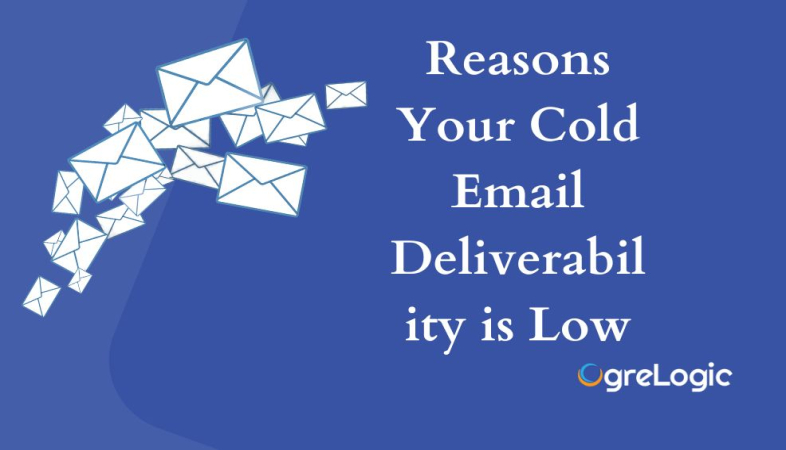
7 Reasons Your Cold Email Deliverability is Low (And How to Fix It)

Getting your cold emails seen is harder than ever. Whether you're trying to book meetings, validate interest in a product, or build your pipeline, poor email deliverability can sabotage your entire campaign. If your open rates are under 30%, there's a good chance your emails are going to spam — and you might not even realize it.
1. Your Domain is New (or Cold)
New domains have no sending history or reputation, so email providers like Gmail, Outlook, and Yahoo treat them with suspicion. If you launch a cold outreach campaign from a brand-new domain without warming it up, it’s like showing up to a job interview in pajamas — you're not taken seriously.
Why this happens: Email service providers (ESPs) use complex algorithms that track the reputation of a domain. If a domain has never sent emails before — or has sent them inconsistently — it's considered risky. High volumes from an unproven source often get flagged as spam.
-
Start small. Begin sending 5–10 emails per day.
-
Warm it up. Use a warm-up tool like Instantly, Warmup Inbox, or Mailreach to send automated conversations between real inboxes. These tools simulate natural conversations and improve sender reputation.
-
Warm-up period: Ideally, warm for 2–4 weeks before launching full campaigns.
-
Avoid links and images in the first week — keep emails plain text.
Pro tip: Buy domains similar to your main brand (e.g., getpipe.com if your brand is pipe.com) and rotate them for outreach to scale safely.
2. You’re Sending Too Many Emails from One Account
Sending hundreds of emails from a single Gmail or Outlook account is a fast way to get flagged — even if your content is good.
Why this happens: Most ESPs have daily and hourly send limits. Gmail, for instance, recommends under 100–150 emails per day for new accounts. Once you exceed this, your messages start getting throttled or blocked entirely.
Fix:
-
Keep it safe: Send 30–60 emails per inbox per day.
-
Scale with multiple accounts: Use 5–10 inboxes with staggered send times.
-
Set up domain variations: If your primary domain is example.com, consider using examplehq.com, getexample.com, etc.
-
Use rotation software: Platforms like Instantly, Smartlead, and Lemlist rotate between accounts to keep volume low per inbox.
Pro tip: Use aliases (first@, hello@, support@) only for communication, never for sending cold emails. Always use human names for cold outreach (e.g., [email protected]).
3. Your Domain is Missing SPF, DKIM, or DMARC
Without proper authentication, email providers assume your messages are suspicious. These three DNS records — SPF, DKIM, and DMARC — act like ID verification for email.
Why this matters:-
SPF (Sender Policy Framework): Defines which servers are allowed to send email for your domain.
-
DKIM (DomainKeys Identified Mail): Encrypts your message with a private key so it can't be forged.
-
DMARC (Domain-based Message Authentication, Reporting, and Conformance): Tells ESPs how to handle mail that fails SPF/DKIM checks.
Fix:
-
Use tools like Google Admin Toolbox, MXToolbox, or EasyDMARC to audit your domain.
-
Update your DNS records in your domain registrar (e.g., GoDaddy, Namecheap, Google Domains).
-
Ask your outreach tool support for recommended SPF/DKIM/DMARC settings.
Pro tip: Use BIMI (Brand Indicators for Message Identification) to show your brand’s logo next to emails once your domain is fully authenticated — it builds instant trust.
4. Your Content is Triggering Spam Filters
Even if your tech setup is perfect, bad copy will land you in spam. Spam filters look at keywords, formatting, links, and structure.
Common red flags:-
Words like “FREE,” “LIMITED OFFER,” “BUY NOW”
-
All caps or excessive punctuation (e.g., “!!!”)
-
Too many links or images
-
Misleading subject lines
Fix:
-
Keep it conversational. Write like you’re emailing a colleague.
-
Test subject lines. Avoid bait-and-switch or overly promotional copy.
-
Personalize. Use merge tags to insert first names, company names, etc.
-
Run a spam check. Use Mail-Tester, GlockApps, or Folderly to score your emails before sending.
Pro tip: Start with plain text only — add links or CTAs only after your first positive reply.
5. Your Email List is Unverified
A dirty list is a dangerous list. High bounce rates can instantly ruin your sender reputation — and get your domain blacklisted.
Why this happens: Cold data often includes fake, old, or mistyped emails. Sending to these invalid addresses leads to hard bounces, which ESPs track aggressively.
Fix:
-
Clean your list with tools like NeverBounce, Bouncer, ZeroBounce, or Instantly Verify.
-
Remove:
- Invalid addresses
- Disposable domains (like mailinator.com)
- Role-based emails (info@, admin@, help@)
-
Use verified lead data sources like Apollo.io, Clay, or UpLead.
Pro tip: Re-verify older lists monthly. Domains expire, jobs change, people bounce.
6. You’re Not Warming Up New Sending Accounts
Even if your domain is warm, every new inbox starts from scratch. Each account has its own sender score.
Why this matters: If you launch a new Gmail and send 50 cold emails from day one, it looks unnatural. ESPs expect a history of human behavior — conversations, replies, thread lengths, and low bounce rates.
Fix:
-
Use auto warm-up platforms to send slow, natural-looking conversations from each new account.
-
Simulate: replies, forwards, opens, and multi-threaded emails.
-
Warm each inbox for at least 2–4 weeks.
Pro tip: Use domains and inboxes solely for warm-up for a few months. These “aged” inboxes can then be rotated into your active cold outreach later.
7. You Have No Technical Monitoring In Place
You can’t fix what you don’t measure. Without data, you’re flying blind.
What you’re missing:
-
Open rates per domain or sender
-
Spam placement indicators
-
Bounce rates (soft and hard)
-
Reply rates and sentiment
-
IP reputation
Fix:
-
Set up Google Postmaster Tools to monitor domain-level reputation.
-
Use GlockApps or Warmup Inbox to test inbox placement.
-
Track campaign-level metrics in your outreach platform (like Instantly or Smartlead).
-
Get alerts for bounce spikes, low engagement, or drop-offs.
Pro tip: Don’t just track — iterate. Use this data to pause poor-performing accounts, improve subject lines, and rotate templates regularly.
Bonus: How to Maximize Cold Email ROI in 2025
Now that your deliverability is dialed in, here’s how to maximize results:
Focus on Intent-Based Targeting
Don’t spray and pray — use signals (hiring, funding, tech stack) to identify high-probability leads.
Use Sequencing Smartly
-
Space out touchpoints across 7–10 days.
-
Vary your messaging angles.
-
Use multichannel touches (LinkedIn, cold call, email).
Test and Iterate Weekly
-
Test 3–5 subject lines and 2–3 CTAs.
-
Measure reply sentiment, not just open rates.
-
A/B test send times (early AM vs. mid-morning).
Clean and Rotate
-
Pause low-performing inboxes.
-
Swap in fresh templates every 1–2 weeks.
-
Refresh lead lists monthly for data quality.
Your Deliverability Is Your Foundation
Cold email is still one of the most powerful outbound channels — but only when your emails actually land in the inbox.
If you’re doing everything else right but ignoring deliverability, it’s like hosting a webinar without sending the invites.
Fix your foundation. Monitor your metrics. And build a system that scales safely.
Why Hire Ogrelogic to Fix It for You?
At Ogrelogic, we’re not just cold outreach experts — we’re also Mailchimp Pro Partners with access to exclusive tools, deliverability insights, and optimization resources that aren’t available to the general public.
-
We build done-for-you cold email systems that get results — whether you're reaching 500 leads or 500,000.
-
Our tech stack includes everything from warm-up protocols and DNS setup to creative copywriting and custom sequencing.
-
We track performance metrics daily and continuously optimize for better deliverability, higher open rates, and stronger replies.
You don’t need to guess. You need a partner who gets you in the inbox, every time.
Book a free discovery call and let’s build a deliverability engine that works for your growth.
Contact us at [email protected] or visit best Email Marketing Agency in Texas








